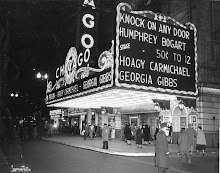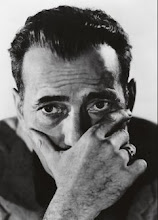Which posed a formidable challenge - how to make a very middle-aged Cagney look credible when portraying Chaney as a young man.
 Director Joseph Pevney's solution was to shoot Cagney almost exclusively in long-shot for three quarters of the movie and also in shadow. Not artistically lit or subtle shadow, mind you. These shadows are big and black and blot out Cagney's face. They're the kind of obscuring shadows that would have the director screaming "cut! cut! CUT!!" on any other film and then chewing out the cameraman in front of the whole crew for lighting the scene so ineptly.
Director Joseph Pevney's solution was to shoot Cagney almost exclusively in long-shot for three quarters of the movie and also in shadow. Not artistically lit or subtle shadow, mind you. These shadows are big and black and blot out Cagney's face. They're the kind of obscuring shadows that would have the director screaming "cut! cut! CUT!!" on any other film and then chewing out the cameraman in front of the whole crew for lighting the scene so ineptly. There is no reason for these shadows other than to obscure Cagney's features. They do nothing to create or enhance mood, or convey a message. These are shadows that put the worst of film noir to shame.
On the couple of occasions when Pevney attempts something resembling a medium close-up he overlights Cagney's face, clumsily but effectively burning out any detail including his wrinkles.
But Pevney's not simply a two or even three trick pony when it comes to concealing the ravages of time. He also has Cagney play several scenes in thick clown face make-up - because that's what we remember Chaney for. You might think that a biopic of Hollywood's first great horror actor might focus the bulk of its attention on recreating those years and films, but MAN OF A THOUSAND FACES spends an inordinate amount of its overlong running time bringing us up to speed on Chaney's vaudeville career. I'm not
doubting that it was an important training ground but do we really need to see the dancing clown routine more than once?
 Actually, if it weren't for Pevney's hamfisted efforts to obscure Cagney's inappropriateness for the part, this film would have very little to recommend it. If writer Ralph Wheelwright's account is to believed (and from some sources I've read it might not be), Chaney's personal life was a little on the turbulent side, but the way it plays out here is so flat, unimaginative and uninspired that it's a chore to stick with it.
Actually, if it weren't for Pevney's hamfisted efforts to obscure Cagney's inappropriateness for the part, this film would have very little to recommend it. If writer Ralph Wheelwright's account is to believed (and from some sources I've read it might not be), Chaney's personal life was a little on the turbulent side, but the way it plays out here is so flat, unimaginative and uninspired that it's a chore to stick with it.Within the limitations previously discussed, Cagney gives a good account of himself, demonstrating his versatility as an actor and a hoofer while suppressing most of the Cagneyisms that characterized many of his performances. But not for one moment did he lose himself in the part, and that meant I never shook the feeling that I was watching him playing a part rather than watching him become the part.


No comments:
Post a Comment